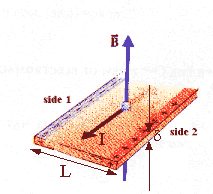The Hall effect
In 1879 Hall discovered a small electric field EH in a conductor
carrying a current I in a magnetic field B. The electric field EH
is perpendicular to both the direction of the magnetic field and the direction of current
flow. Hall used this observation to prove that the current in metal conductors is carried
by negative charges.
 The current in the metal strip shown is flowing because a power supply
establishes an electric field E in the strip. The conduction electrons move with an
average drift velocity vd opposite to the direction of E.
In the uniform field B the magnetic force on each electron is F =
-qevd × B. It causes the electrons to drift towards side 1 of the
strip, leaving excess positive charge on side 2. These separated charges produce the
electric field EH. The electrons will stop drifting sideways, when the
electric force -qeEH cancels the magnetic force -qev × B,
or EH = vdB. The resulting potential difference across the strip is
The current in the metal strip shown is flowing because a power supply
establishes an electric field E in the strip. The conduction electrons move with an
average drift velocity vd opposite to the direction of E.
In the uniform field B the magnetic force on each electron is F =
-qevd × B. It causes the electrons to drift towards side 1 of the
strip, leaving excess positive charge on side 2. These separated charges produce the
electric field EH. The electrons will stop drifting sideways, when the
electric force -qeEH cancels the magnetic force -qev × B,
or EH = vdB. The resulting potential difference across the strip is
EHL = ΔV = V2 - V2 = vdBL.
This is known as the Hall potential.
If positive charges were moving in the strip, they would drift towards side 1
and the sign of the Hall potential would change
The Hall effect can be used to measure the strength of the magnetic field perpendicular
to a current-carrying metal strip, called a Hall probe. The dimensions of the probe and
the drift velocity for a given power-supply voltage are known. The potential difference ΔV then yields the magnetic field strength B┴.
Problem:
 A
current I is flowing in the metal strip of width L and thickness δ as shown .
The metal contains ne free electrons per unit
volume. A magnetic field B penetrates the strip as shown. In
terms of I, B, ne, and L, find the potential difference between
side 1 and side 2.
A
current I is flowing in the metal strip of width L and thickness δ as shown .
The metal contains ne free electrons per unit
volume. A magnetic field B penetrates the strip as shown. In
terms of I, B, ne, and L, find the potential difference between
side 1 and side 2.
Solution:
- Reasoning:
The magnitude of the current I moving through a wire is given by
I = |ρ-|<v->A = neqevdA,
where ne is the number of free electrons per unit volume.
The current I equals the number of electrons that pass any point along the wire
per second times the unit of charge qe. <v-> = vd is the drift
speed of the electrons. It is their average speed, as they move along the
wire.
We have vd = I/(neqeA) = I/(neqeLδ).
∆V = vdBL = IB/(neqeδ).
 The current in the metal strip shown is flowing because a power supply
establishes an electric field E in the strip. The conduction electrons move with an
average drift velocity vd opposite to the direction of E.
In the uniform field B the magnetic force on each electron is F =
-qevd × B. It causes the electrons to drift towards side 1 of the
strip, leaving excess positive charge on side 2. These separated charges produce the
electric field EH. The electrons will stop drifting sideways, when the
electric force -qeEH cancels the magnetic force -qev × B,
or EH = vdB. The resulting potential difference across the strip is
The current in the metal strip shown is flowing because a power supply
establishes an electric field E in the strip. The conduction electrons move with an
average drift velocity vd opposite to the direction of E.
In the uniform field B the magnetic force on each electron is F =
-qevd × B. It causes the electrons to drift towards side 1 of the
strip, leaving excess positive charge on side 2. These separated charges produce the
electric field EH. The electrons will stop drifting sideways, when the
electric force -qeEH cancels the magnetic force -qev × B,
or EH = vdB. The resulting potential difference across the strip is A
current I is flowing in the metal strip of width L and thickness δ as shown .
The metal contains ne free electrons per unit
volume. A magnetic field B penetrates the strip as shown. In
terms of I, B, ne, and L, find the potential difference between
side 1 and side 2.
A
current I is flowing in the metal strip of width L and thickness δ as shown .
The metal contains ne free electrons per unit
volume. A magnetic field B penetrates the strip as shown. In
terms of I, B, ne, and L, find the potential difference between
side 1 and side 2.